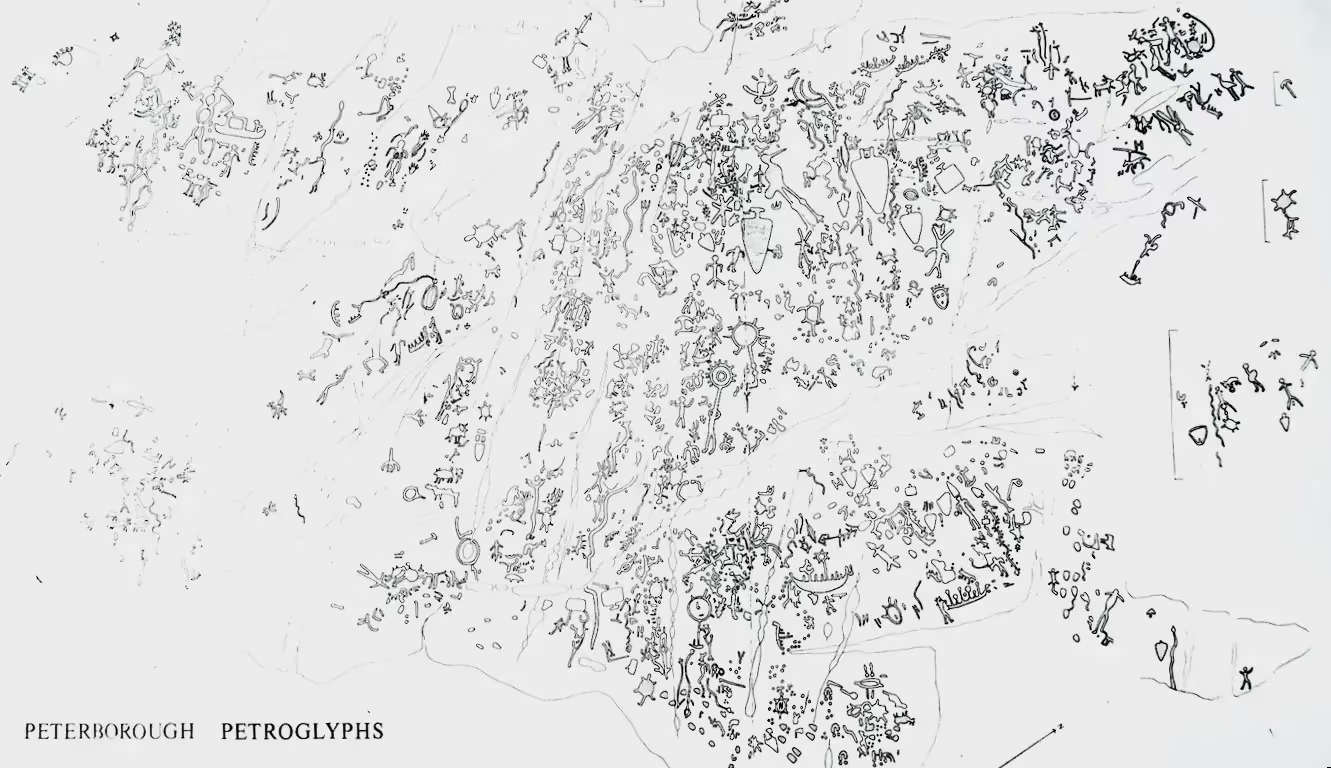Nordic King Woden-Lithi's visit to Canada, 1700 BC
Woden-Lithi
1700 BC: A Nordic king named Woden-Lithi sailed across the Atlantic and entered the St Lawrence River. He reached the neighbourhood of where Toronto now stands, and established a trading colony with a religious and commercial centre at the place that is now known as Petroglyphs Park, North of Peterborough, Ontario. His homeland was Norway, his capital located at Ringerike, west of the head of Oslo Fjord. He remained in Canada for five months, from April to September, trading his cargo of woven materialfor copper ingots obtained from the local Algonquians (whom he called Wal, aword cognate with Walesand Welsh and meaning “foreigners”).
He left behind an inscription that recorded his visit, his religious beliefs, a standard of measures for cloth and cordage, and an astronomical observatory for determining the Nordic calendar year, which began in March, and for determining the dates of the Yule and pagan Easter festivals. Having provided his colonists with these essentials, he sailed back to Scandinavia and thereafter disappears into the limbo of unwritten Bronze Age history.
The king’s inscription gives his Scandinavian title only and makes no claim to the discovery of the Americas or to the conquest of territory. Clearly he was not the first visitor to the Americas from Europe, for he found that the Objibwa Algonquians were already acquainted with the ancient Basque syllabary, and when Woden-Lithi set sail for home, an Objibwa scribe cut a short comment into the rock at the site, using the ancient Basque script and a form of Algonquian still comprehensible today, despite the lapse of time.
Around the shores of Lake Superior, and on the adjacent Ile Royale, there are approximately 5000 ancient copper mine workings. These ancient mining pits have been carbon dated to between 2000 BC and 1000 BC. These dates correspond roughly to the start and end of the Bronze Age in Northern Europe. The most conservative estimates by mining engineers show that at least 500 million pounds of metallic copper were removed over that time span, and there is no evidence as to what became of it. Archaeologists have maintained that there was no Bronze Age in Northern America and that no contacts with the outside world occurred. Woden-Lithi’s inscriptions declare that copper ingots were his primary targets in coming to Canada. Previous shippers must have passed the information to the Norse king, since otherwise he could not have known that copper was available and that a suitable trade commodity in exchange would be woven fabrics and cordage. It would appear that European colonists and traders have been visiting or settling in the Americas for thousands of years, have introduced their scripts and artifacts and skills, and have exported abroad American products such as copper.[1]
[1] Barry Fell, Bronze Age America,(Toronto: Little, Brown & Company, 1982), p. 1 introduction.
More information can be view at these links:
http://www.faculty.ucr.edu/~legneref/bronze/bronze1.htm#Introduction
http://www.jwwerner.com/history/PETROGLYPHS.html
http://www.jwwerner.com/history/PETROGLYPHS.html

Overview of the site.

Map of the Petroglyphs. (Peter Albinger drawing)
Mayanologist David H. Kelley viewed the petroglyphs and declared that some of the symbols were European, dating perhaps to ca. 1000 BC.~ According to Andis Kaulins and Megaliths.co.uk, the petroglyphs are a sky map of the heavens from c.3117 BC based on European tradition; they have nothing to do with Native American traditions.

A young woman shining bright. (Wikipedia)
Elder Futhark (2nd to 8th centuries)
The 24 Elder Futhark runes are the following:

The Elder Futhark, used for writing Proto-Norse, consists of 24 runes that often are arranged in three groups of eight; each group is referred to as an ætt (Old Norse, meaning 'clan, group'). The earliest known sequential listing of the full set of 24 runes dates to approximately AD 400 and is found on the Kylver Stone in Gotland, Sweden.Most probably each rune had a name, chosen to represent the sound of the rune itself. The names are, however, not directly attested for the Elder Futhark themselves. Germanic philologists reconstruct names in Proto-Germanic based on the names given for the runes in the later alphabets attested in the rune poems and the linked names of the letters of the Gothic alphabet. For example, the letter /a/ was named from the runic letter Runic letter ansuz.svg called Ansuz. An asterisk before the rune names means that they are unattested reconstructions.

The twenty standard letters of the Ogham alphabet and six forfeda. The letter labelled IA (Ifín) earlier had the value of p. An additional (secondary) letter p is shown as 26th character (peith). This is the vertical writing of Ogham; in the horizontal form, the right side would face downward.

